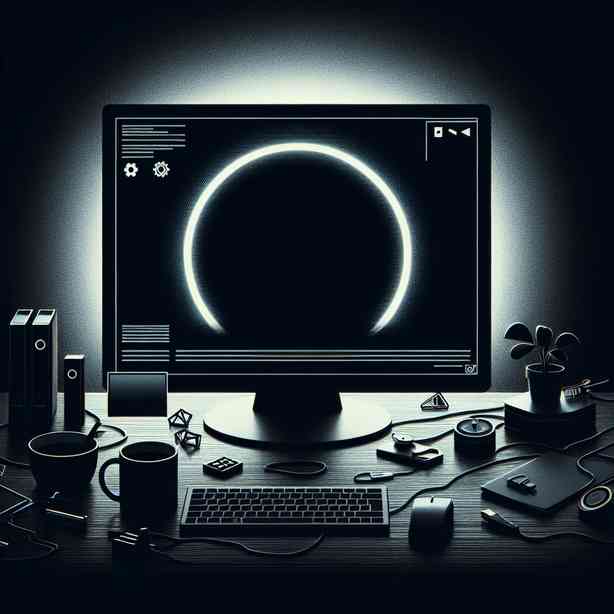
When your desktop turns completely black, it can be a disconcerting experience. Many users might panic, thinking that their entire system is compromised or that they have lost important data. However, this common issue often has several straightforward explanations and solutions that you can explore before considering a more drastic course of action. In this article, we will delve into the various reasons behind a black desktop screen and guide you through the steps you can take to resolve the issue.
One of the primary reasons for a black desktop screen can be attributed to the graphics driver problems. The graphics driver is essential for your operating system to communicate with the graphics card, and if there is a malfunction, it could result in a black screen. Updating your graphics driver might resolve the issue, so it’s advisable to check for any available updates. You can do this by going to the Device Manager on Windows, locating your graphics card, and selecting the option to update the driver. If there’s a new version available, the update may restore your desktop back to its original state.
Another common cause of a black screen might be related to recent software installations or updates. Sometimes, a newly installed program can conflict with existing software or system settings, leading to display issues. If you suspect that this might be the case, try booting your computer in Safe Mode. Safe Mode employs a minimal set of drivers and services, which can help you determine if the issue is indeed tied to a recent software change. If the black screen disappears in Safe Mode, you may want to uninstall any apps or updates you have recently installed to see if that resolves the conflict.
Hardware issues can also lead to a black screen. Problems with the monitor, cable connections, or graphics card can create display issues as well. First, ensure that your monitor is receiving power and is turned on. Check the cables connecting your monitor to your computer and make sure they are securely connected. If possible, try using a different monitor or cable to determine if they are causing the issue. Testing different hardware components can often reveal the source of the problem.
If you’re using multiple monitors, it is also worth investigating how your display settings are configured. Sometimes, the operating system may not recognize multiple monitors properly, defaulting to one that isn’t active. Right-click on your desktop and go to Display Settings to check if all connected displays are detected and configured correctly. Adjusting these settings may restore your desktop view.
In some cases, the black desktop issue may stem from corrupted user profiles. If your profile is damaged, it can prevent the graphical user interface from loading correctly. To test this, you might consider creating a new user account on your computer. If the new account works fine without displaying a black screen, it could indicate that your original profile is corrupted. You can then migrate your files from the old profile to the new one.
Operating system corruption is another potential cause of a black screen. System files may become corrupt due to improper shutdowns, power outages, or malware. Running a system file checker can help detect and repair these issues. To do this on Windows, you can open Command Prompt as an administrator and type “sfc /scannow.” Once the process is complete, restart your computer and check if the issue persists.
Malware can also wreak havoc on your system, potentially leading to a black screen. Running a full scan with an updated antivirus program is highly advisable. Malware can interfere with various system operations, so removing any malicious software could help restore your display. Additionally, regularly updating your antivirus software can help prevent future infections.
If you’ve tried all these steps and still find yourself staring at a black screen, it may be time to consider a system restore or reset. A system restore can revert your computer to a previous state, effectively undoing recent changes that might have led to the problem. Navigate to the Control Panel and access the Recovery options to initiate a system restore. Keep in mind that this process could result in the loss of some programs or updates installed after the restore point, so be sure to back up any important data beforehand.
In extreme cases where a black desktop screen is accompanied by persistent performance issues, it could indicate a failing hard drive or other hardware-related problems. Utilizing diagnostic tools to check the health of your hard drive may be necessary. Many manufacturers provide built-in diagnostic tools, or you can use third-party software designed for hardware analysis. Should your hard drive be on the verge of failure, consider replacing it to avoid data loss.
The black desktop screen is a frustrating issue, but it’s important to remember that many potential fixes are available. Staying calm and methodically troubleshooting the problem can lead you to a resolution. Maintaining regular backups of your data, updating your software, and being cautious when installing new programs can help minimize the chances of encountering this issue in the future.
In conclusion, a black desktop screen can arise from various issues ranging from software conflicts to hardware malfunctions. Understanding potential causes helps in systematically approaching the problem. Whether it’s updating drivers, checking hardware connections, or running antivirus scans, there are multiple avenues to explore in resolving the situation. If all else fails, enlisting professional help can always be a reliable option. By taking these proactive measures, you can ensure a smoother computing experience and keep your desktop looking vibrant and functional.


